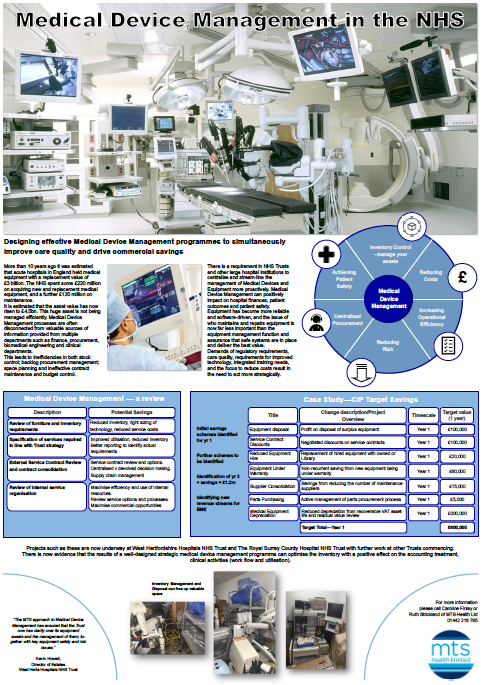Healthcare / Procurement
European Healthcare Design 2018
Designing effective medical device management programmes to simultaneously improve care quality and drive commercial savings
By Caroline Finlay, Ruth Strickland and Andrew Frost | 08 Jun 2018 | 0
This poster will demonstrate how a comprehensive approach to medical device management can positively impact on hospital finances, patient outcomes and patient safety.
Abstract
Designing effective medical device management programmes to simultaneously improve care quality and drive commercial savings
In 1996–97, it’s estimated that acute hospitals in England held medical equipment with a replacement value of some £3 billion. They spent some £220 million on acquiring new and replacement medical equipment, and a further £120 million on maintenance. In 2017, this rose to an estimated £4 billion spend.
The principle is the same in most European hospitals. Yet, equipment finance, procurement, and management requirements are often driven by competent but disconnected processes. In 2011, the UK’s National Audit Office recommended: “Procurement of medical equipment needs to be better co-ordinated across trusts, with more involvement of technical personnel. They can also usefully contribute to non-clinical aspects of user training. We also recommend action that should help to improve the standards of reporting of adverse safety incidents, and to reduce their occurrence.”
Purpose/objectives: This poster will demonstrate how a comprehensive approach to medical device management can positively impact on hospital finances, patient outcomes and patient safety. As equipment becomes more reliable and software-driven, the issue of who maintains and repairs equipment is far less important than the equipment management function, and achieving best value and assurance. Demands of regulatory requirements, care quality, requirements for better technology, integrated training needs, and a focus to reduce costs result in the need to think more strategically.
Methods: Case studies of where cost improvements, budget reduction, and an increase in quality of the service have been delivered and achieved will be presented from the Royal Surrey, Great Ormond Street Hospital for Children, and West Herts Hospital.
Results: The poster demonstrates the results of well-designed strategic medical device management programmes, and how investment can support training for clinical professionals, transform processes, governance and compliance at the same time as reducing unnecessary lifecycle costs, and achieving various care quality benefits.
Conclusions: This issue should be at executive level on hospital boards. Hospitals in the UK and Europe are only just beginning to focus on a more commercial view of managing assets, including medical equipment, realising there are savings to be made in managing their assets more efficiently. Equipment management structures must have the right set of tools to manage the performance of equipment assets, be patient-focused, and operate in an efficient manner, to drive improvements in service provision and cost at the same time as meeting all governance and patient safety standards.
Organisations involved


